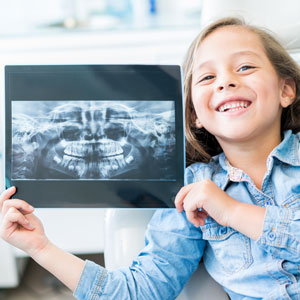Our advanced CBCT 3D X-ray technology gives a more complete picture of your oral anatomy than 2D imaging, which often misses critical health issues hidden behind another tooth.
How It Works
CBCT is just like a hospital CT scan, but with less radiation. It makes a 3D map of your teeth and bones so we can give an accurate diagnosis.
The process is similar to taking 2D X-rays. It takes 10 seconds to capture each image, so you won’t have to hold still for too long. Even better, there’s no need to place film inside your mouth, making your experience more comfortable.
This device uses a low dose of radiation. It is considered safe for everyone, including children. We only take imaging when you truly need it to minimise your exposure. Sometimes, taking one CBCT scan gives us the same information we would need several traditional X-rays to capture, thus reducing your total radiation dosage.
Improving Treatment to Meet Your Needs
 For patients needing implants, CBCT can help us see if you have enough bone volume, whether you need a bone graft, and if any nerves or sinuses are nearby.
For patients needing implants, CBCT can help us see if you have enough bone volume, whether you need a bone graft, and if any nerves or sinuses are nearby.
If you need a root canal, we’ll use CBCT to locate the number and shape of affected canals. We might need 3D X-rays before extracting wisdom teeth or any other tooth. Identifying hidden or curved roots in advance will give us a better idea of the difficulty and risk involved, so we can recommend surgical extraction if necessary.
Dr Andrew (Dentist) will also use 3D scanning to diagnose the amount and degree of bone loss in patients with periodontal disease.
Better Technology for a Better Smile
By offering the latest in advanced technology, we make treatment safer and more precise. Reach out to our team today so we can give you the whole picture on 3D imaging.
Any invasive or surgical procedure may carry risks. Before moving forward, it is recommended that you seek a second opinion from an appropriately licensed medical professional.
